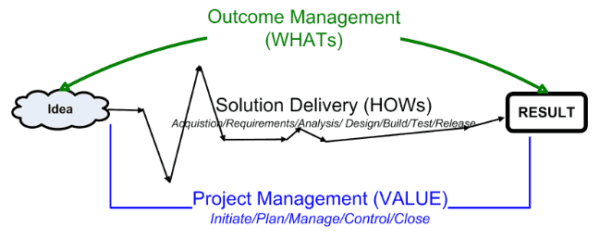We manage so many things when we manage project portfolios. It is important to understand the difference between outcome management, project management, and solution delivery.
The process of turning an idea into a result that delivers or contributes to a strategy consists of three elements:
- Outcome management: Asks the question, how well did the actual result match the intended result?
- Solution delivery: Which asks the question, what is the path to transforming an idea into a result?
- Project management: Which looks at whether the result adds value?

Outcome management, project management, and solution delivery: say what?
The most important place to start is defining what the result looks like. As Lewis Carroll said, “If you don’t know where you are going, any road will get you there.” If you’re a baseball fan, Yogi Berra simply said, “you’ll end up someplace else.” Vaguely defined results make it challenging to manage stakeholder expectations and establish an accurate budget or schedule. My litmus test is simply to determine if one sentence, also known as a business requirement or user story, is complete: “As a [who wants the result or strategy?], I want [describe the result or strategy], so that [a statement of how the result or strategy delivers value].” If your stakeholders can agree on how to fill in the blanks, you are in great shape.
Do not confuse the ‘what’ with the ‘how.’ Does the definition of the result contain names of technology systems? Mention a supplier? Include dates or costs? Refer to solution delivery activities? If so, you have described how the result will be delivered, not the result itself.
The process of transforming an idea into a result so your portfolio’s outcome can be measured is not a linear one. My personal experience on this journey is remarkably consistent: It feels like the idea is a cloud that continues to grow and morph and expand the more you explore it; after a period of time, that cloud crystallizes with the clarity that comes from a shared understanding. Enjoy exploring the idea cloud! You will know when the time is right to put a structure on that ambiguity.
Speaking of which, just how do you go about measuring your project portfolio’s outcome? With a corresponding scope statement, of course! Remember, your project portfolio’s success is determined by how well cost and schedule remain aligned with the outcome’s scope. Your project portfolio needs to deliver the value intended at the beginning (with agreed-upon changes) your credibility depends on it.
Why is that line not straight?
Solution delivery is the backbone that makes it possible to realize the most value for your project portfolio investment. Without it, there is no outcome to manage. Without an outcome…well, see the “Say what?” section of this article.
That line from idea to result is intentionally not straight. If your stakeholders expect a straight line, you have got some expectation management to do. Personally, I have never managed a project portfolio that performed exactly according to the initial plan unless the duration was less than one week (then, it is likely a project and not a portfolio). It is a myth that the project portfolio is in control as soon as the project portfolio manager is assigned. A good rule of thumb is that approximately 40 percent of the work is not even in the initial plan. Expect your portfolio to pivot the most in the earlier stages, when requirements are defined and when designs are created or validated against requirements.
A generic solution delivery process contains references to key activities that define the path from idea to result. Those activities have names like acquisition, requirement definition, design, build, test, and release. Solution delivery activities should not be confused with project portfolio management activities (inventory, analyze, align, manage) or project management processes (initiate, plan, manage, control, close). The solution delivery activities appear in the plan and are elaborated to create cost and schedule performance information.
Choose your project managers wisely.
There is a direct correlation between the skill and experience of your project managers (or scrum masters) and how well your project portfolio performs because projects in your portfolio deliver the value and benefits expected by your stakeholders. Project managers are determining the accuracy of the solution delivery path, applying an appropriate process to navigate that path, encouraging the resources contributing to the progress along that path, and monitoring project performance along that path, so your portfolio dashboard is current and accurate. Among other things! When it comes to outcome management, project management, and solution delivery, take the time to assess their experience and their fit with your team, then support them to the best of your ability. You will be richly rewarded.
Similar Content:
-
Don’t let your scope definition gather dust!
-
5 Secrets of strategic growth using portfolio management principles
-
Taking a portfolio view: Why strategy drives projects

